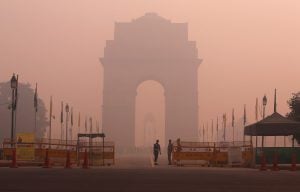The second phase of Delhi’s odd-even policy – a fortnight during which cars having odd and even numbered plates were allowed to ply on roads on odd and even dates respectively – ended on April 30. The Delhi government has called it a success, and announced a thanksgiving event to be held on the May 4, but it is unclear what the parameters of this success truly are.
High compliance
Addressing the media, Delhi’s Transport Minister, Gopal Rai, said, “Odd-even has been tried out partially or wholly in at least 14 countries across the world but India is the first one that has executed it successfully in the second phase too. The phase two was a tougher test than the phase one. This time a total of 8,988 vehicles were fined and going by this figure, it shows that the compliance rate during this odd-even was 99.6%.”
The odd-even scheme was first introduced during January this year between January 1-15 with an aim to counter air pollution and traffic congestion of the capital city in India. After the completion of the scheme during the first phase, the experiment drew major support from the citizens with 81% of them voting in favour of its return according to a large-scale referendum that was conducted.
See: Odds in favour of odd-even in Delhi
See: Delhi’s odd/even scheme inspires, even with mixed results
Does limiting the number of cars impact air pollution?
Delhi’s air quality, which has a direct impact on human health, has critically worsened over the years with dust, vehicular pollution and weather conditions cited as the main causes. It is debatable how much of the air pollution is caused by the private vehicles, but given that Delhi has the highest proportion of car users in the country, the encouragement, or discouragement, of the use of private vehicles has a demonstration impact across the country. Commuting by private transport is still very low in India, and only about 10% of Delhi’s public commutes by car. As public transport creates less pollution per consumer, this is a roundabout way to deal with air pollution – to limit the use of cars even before their use becomes the norm.
According to Rai, due to implementation of the odd-even scheme, the mindset of car consumers is changing. He said that the number of registration of new vehicles has seen a drop ever since the scheme came into effect. According to government data, the number of vehicles that were registered between 1 September 2015 – 31 December 2015 (four months before the first phase of odd-even) was 237,228 vehicles while the registration during 1 January – 30 April (four months after the odd-even was implemented for the first time) fell to 166,130 – showing a drop of 30%.
As far as the air pollution and traffic congestion is concerned, there are mixed reviews. The Delhi government claimed that Delhi Pollution Control Committee (DPCC) is currently monitoring the air pollution at 74 locations which will get over on May 6, following which the air quality data and the impact of odd-even scheme would be revealed on May 9.
Impact on congestion
An independent NGO, Safe Road Foundation, also found that reduction in traffic congestion was marginal this time as compared to previous time the scheme was implemented. According to Mohammad Imran, founder of the Safe Road Foundation there was a 30-35% of reduction in congestion on roads last time while this time it was just 10-15%.
Imran said, “This time there is lot of anger among people that why this policy was put in place without adequate research. This time, we have spoken to over 100 people at least and this is what we observed. We also felt that people said they would buy a second car if it becomes permanent. Also, people have bought second cars at cheap rates for their convenience. It wasn’t that effective this time as earlier.”
However, Neha, a professional working in Okhla, east Delhi said, “The traffic was definitely less this time as well. I really enjoyed odd-even as driving was enjoyable for me. However, I feel that women drivers shouldn’t be exempted from the odd-even drive.”
Women and two-wheeler riders were exempted from the scheme due to lack of safe and robust public transport. Since schools were open this time as opposed to January, there was more traffic on the roads.
Limited data
As far as pollution level is concerned, while the Delhi government is yet to release the data, a study by the Massachusetts Institute of Technology (MIT) said that even though compliance was high, more people opted for a second car this time. Under the project, feedback was taken from over random 900 commuters plus a survey of over 3,000 people was conducted over the phone.
The MIT report said that 18.8 % of the people said they used a second car as opposed to nearly 7% during phase one. So there appeared to be an increase in people using second cars.
As far as air quality is concerned, researchers from Centre for Science and Environment (CSE) are currently analysing data collected by the Delhi Pollution Control Committee (DPCC). CSE observed spikes in ozone levels during the second week of odd-even. Polash Mukerjee, Researcher, Clean Air and Sustainable Mobility, CSE said that ozone dominated all the conversations among researchers.
Ozone worries
“Ozone is a composite pollutant which covers nitrogen dioxide and sulphur dioxide, therefore its presence is an indicator of the presence of other pollutants,” he said.
Mukherjee further added that during the second week temperature was high and probably due to that the spikes were seen. “These toxic gases like sulphur dioxide and nitrogen dioxide are oxidized in the presence of high temperature which acts as a catalyst and ozone is formed as a by-product,” he explained.
The national ambient safe standard for ozone is 180 micrograms per cubic metre. CSE said that it touched 420 micrograms per cubic metre on April 29. Nevertheless this was lower than the measurements last April.
An emergency solution
CSE cautioned that the success of the odd-even strategy should not be based on the level of pollution, or congestion, instead it should be seen as an emergency solution. “Whenever pollution levels get critical in the city, odd-even should be applied on all cars and scooters. It should be a response to high pollution level instead of being looked at the sole measure of cutting air pollution.” It then showed that although pollution had declined for the first ten days, it had gone up thereafter – because of forest fires and crop burning in neighbouring states. While this does show that the scheme was effective, it also highlights that car pollution is only a part – even a small part of the larger challenge of dealing with Delhi’s air pollution.
This means that the government needs to take up measures that stop such emergencies from recurring. For this, Delhi will have to focus on short term and long term measures including clean fuels, stricter parking policies, and better public transport infrastructure to curb air pollution in the long run.
In the meanwhile, the Delhi government is planning to bring back the odd even scheme in July when the schools will be shut so that parents dropping their children at schools will not face a problem. It has said that it will wait until September before making this scheme a permanent feature. But is a permanent state of emergency really a success?
![<p>Volunteers on the road [image courtesy PTI]</p>](https://dialogue.earth/content/uploads/2016/05/odd-even-rule-l-pti.jpg)




![Black-necked cranes on the Naymjang Chu riverbed near Zemithang village of Pangchen valley in Tawang district. [image by Lham Tsering]](https://dialogue.earth/content/uploads/2016/05/2.-Black-necked-cranes-on-the-Naymjang-Chu-riverbed-near-Zemithang-village-of-Pangchen-valley-in-Tawang-district.-Photo-by-Lham-Tsering-300x190.jpg)

